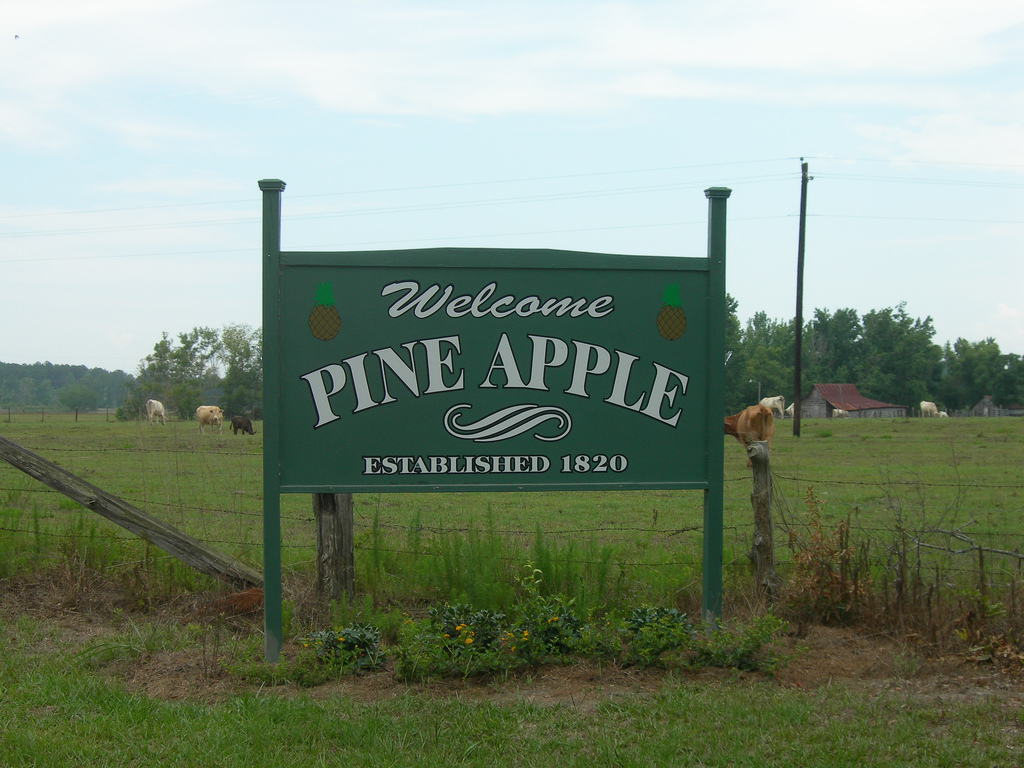Pine Apple, Alabama

Location of Pine Apple in Wilcox County, Alabama.
Visit Pine Apple….. The home of Friendship, Southern hospitality and Welcome!
Pine Apple is a town in eastern Wilcox County,Alabama, located 20 miles East of Camden on Alabama Highway #10 and 20 miles West of Greenville from exit 128 off Interstate I-65.
From the mid-1850s to the early twentieth century, Pine Apple was one of many Black Belt communities nourished by the cotton industry.
Pine Apple, Alabama History
Founded in 1825, the town of Pine Apple became a regional commercial center due to its strategic location as the end of the Selma, Alabama to Pensacola, Florida Railroad line from 1871 to the 1890s. Pine Apple was officially incorporated by the state of Alabama in 1872. During the mid- and late nineteenth century, the town’s growth was fueled by Wilcox County‘s booming cotton industry.
In addition to cotton gins and sawmills, the town included a doctor’s office, pharmacy, bank, hotel, and newspaper. Pine Apple was also home to Moore Academy, a prominent public 12-grade school founded in 1883 by educator and writer Dr. John Trotwood Moore.
On December 25, 1903, a fire that began in the town jail spread quickly and destroyed nearly all of Pine Apple’s business district. The town was later rebuilt and continued to prosper. According to the 1910 Census, the population of Pine Apple was 627. The town grew until 1967, when the Bank of Pine Apple (founded in 1903) closed. Following the bank closure, the general store, cotton mill, and saw mill also went out of business.
The progressive spirit of Pine Apple during the centennial period 1850 to 1950 is reflected in its historic commercial, residential, civic, educational, and religious architecture, namely the Bank of Pine Apple building, Pine Apple Water Tower and Waterworks building, Moore Academy, Matheson Community Library, Pine Apple Methodist Church and Friendship Baptist Church.
How Did Pineapple Alabama Get Its Name
Pine Apple was originally called Friendship, and under the latter name was laid out in 1825. The present name was given in 1852 on account of there being pine and apple groves near the town site.
Pine Apple Places of Interest
The Pine Apple Historic District, entered into the National Register of Historic Places on February 26, 1999, includes 73 properties from the mid-19th to the mid-20th century. The historic district draws visitors from near and far for viewing of the residential architecture ranging from 19th century cottages and early 20th century bungalows to more academic application of the Greek Revival, Queen Anne, and Colonial Revival styles.
Friendship Baptist Church
Hawthorne House, Pine Apple Alabama
Hawthorne House is a two-story, wood-frame plantation home commissioned by Joseph Richard Hawthorne in 1852. The property has been restored and has been on the National Register of Historic Places since 1985.
More

Bank Of Pineapple
Moore Academy Pineapple Alabama
Pineapple Methodist Church
Founded by circuit riders as the Methodist Episcopal Church South, the first minister was Rev. A Gillis. Several additions have been made to the 1872 original building, including the present altar and front classrooms of the main sanctuary. The two-story educational building was erected in the early 1950’s. The Victorian style steeple consists of ornamental cast iron finial, tin sheeted cone, bell, and bell pavilion with jigsaw work brackets and balustrade. The cemetery contains late 19th and 20th century monuments, mostly divided into familiarly grouped plots.
Source: Pine Apple Promotion, Inc.
More
Pine Apple Alabama Weblinks
Pine Apple Events
Pine Apple is widely known as a deer and turkey hunting Mecca. Local Hunting lodges offer hunts that include meals and lodging.
The town is supported by Pine Apple Promotions, Inc. an active service league dedicated to the beautification and preservation of Pine Apple and its history.
